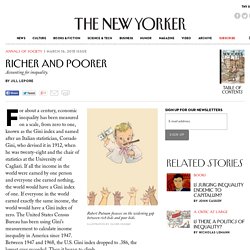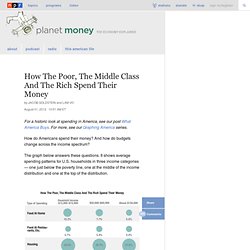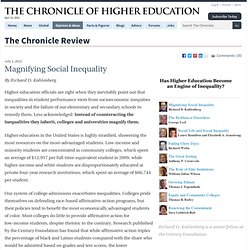

Why Inequality Persists in America - The New Yorker. For about a century, economic inequality has been measured on a scale, from zero to one, known as the Gini index and named after an Italian statistician, Corrado Gini, who devised it in 1912, when he was twenty-eight and the chair of statistics at the University of Cagliari.

If all the income in the world were earned by one person and everyone else earned nothing, the world would have a Gini index of one. If everyone in the world earned exactly the same income, the world would have a Gini index of zero. The United States Census Bureau has been using Gini’s measurement to calculate income inequality in America since 1947. Between 1947 and 1968, the U.S. Gini index dropped to .386, the lowest ever recorded. Income inequality is greater in the United States than in any other democracy in the developed world. The evidence that income inequality in the United States has been growing for decades and is greater than in any other developed democracy is not much disputed. Why Poor Schools Can’t Win at Standardized Testing. You hear a lot nowadays about the magic of big data.

Getting hold of the right numbers can increase revenue, improve decision-making, or help you find a mate—or so the thinking goes. In 2009, U.S. Education Secretary Arne Duncan told a crowd of education researchers: “I am a deep believer in the power of data to drive our decisions. Data gives us the roadmap to reform. It tells us where we are, where we need to go, and who is most at risk.” This is a story about what happened when I tried to use big data to help repair my local public schools. A few years ago, I started having trouble helping my son with his first-grade homework. “I need to write down natural resources,” he told me.
“Air, water, oil, gas, coal,” I replied. “I already put down air and water,” he said. How The Poor, The Middle Class And The Rich Spend Their Money : Planet Money. For a historic look at spending in America, see our post What America Buys.

For more, see our Graphing America series. How do Americans spend their money? And how do budgets change across the income spectrum? The graph below answers these questions. The Burdens of Working-Class Youth - The Chronicle Review. By Jennifer M.

Silva Brandon, a 34-year-old black man from Richmond, Va., labels himself "a cautionary tale. " Growing up in the shadow of a university where both his parents worked in maintenance, he was told from an early age that education was the path to the "land of milk and honey. " An eager and hard-working student, Brandon earned a spot at a private university in the Southeast—finally, his childhood dream of building spaceships seemed to be coming true.
He shrugged off his nervousness about borrowing tens of thousands of dollars in loans, joking: "Hey, if I owe you five dollars, that's my problem, but if I owe you $50,000, that's your problem. " How America's 2-Tiered Education System Is Perpetuating Inequality - Emily Chertoff. President Obama, with Eduardo Padrón (left), receives an honorary Associates of Science degree from Miami-Dade College in 2011.

(Larry Downing/Reuters) In 2006, Amherst College made a decision that administrators at some other schools considered radical. 2-Year Colleges Are at Risk of 'Separate and Unequal' Future, Report Says - Administration. By Goldie Blumenstyk Washington Community colleges "are in great danger of becoming indelibly separate and unequal institutions in the higher-education landscape," a Century Foundation task force warns in a report being released here on Thursday.

To deal with what it calls "the increasing economic and racial isolation of students" at community colleges, the group also calls for major changes in how two-year colleges are financed and operated. Among its recommendations, the group urges states and the federal government to provide additional funds to two-year colleges that serve the neediest students, much in the way the federal Title I program works for elementary and secondary schools. In states where constitutional guarantees of education might extend to higher education, the report suggests that advocates even consider filing lawsuits to require such "adequate funding" of community colleges. Radical Change Needed. How the Billionaire boys Club is running - and ruining - education. First, let's set the scene, or if you will, the justification used for the actions advocated by the "reformers" funded by the Billionaire Boys Club.

At least since a Nation at Risk in 1983, the American people have been hammered with the theme that our students are falling behind in international competitions. We heard that again with the release by OECD of the most recent PISA scores. But we should remember the caution of Mark Twain he attributed in part to Disraeli, "There are three kinds of lies: lies, damned lies and statistics. " Perhaps if we follow the logic of No Child Left Behind and insist upon a disaggregation of the scores on international tests we can see that the figures tell a story quite different than that pushed by the organizations backed by the Billionaire Boys Club. students in U.S. schools where the poverty rate was less than 10 percent ranked first in reading, first in science, and third in math. Barkan seeks to explore 3 questions: How Colleges Punish Families Who Choose to Save - Daniel Indiviglio - Business.
Schools and the government should focus on income, not savings, when awarding financial aid assistance Throughout the U.S., millions of parents struggle to save for their children's college education.

It isn't easy: in a consumer culture like ours, there's always something new to buy. Driving an older car, using an out-of-date computer, and ignoring cool new gadgets like the iPad aren't easy -- particularly when you've got some income that you could be spending on such luxuries. No wonder seeing the U.S. savings rate as high as 6% is unusual. But those parents who do the responsible thing and save are discriminated against: students whose parents save less often qualify for more financial aid. If you or one of your children has gone to college over the past 15 years, then you're probably familiar with the Free Application for Federal Student Aid ("FAFSA"). FAFSA's influence doesn't begin and end with the government. An Example Let's make this example concrete. Education and Inequality. By Richard D.

Kahlenberg Higher-education officials are right when they inevitably point out that inequalities in student performance stem from socioeconomic inequities in society and the failure of our elementary and secondary schools to remedy them. Less acknowledged: Instead of counteracting the inequalities they inherit, colleges and universities magnify them.